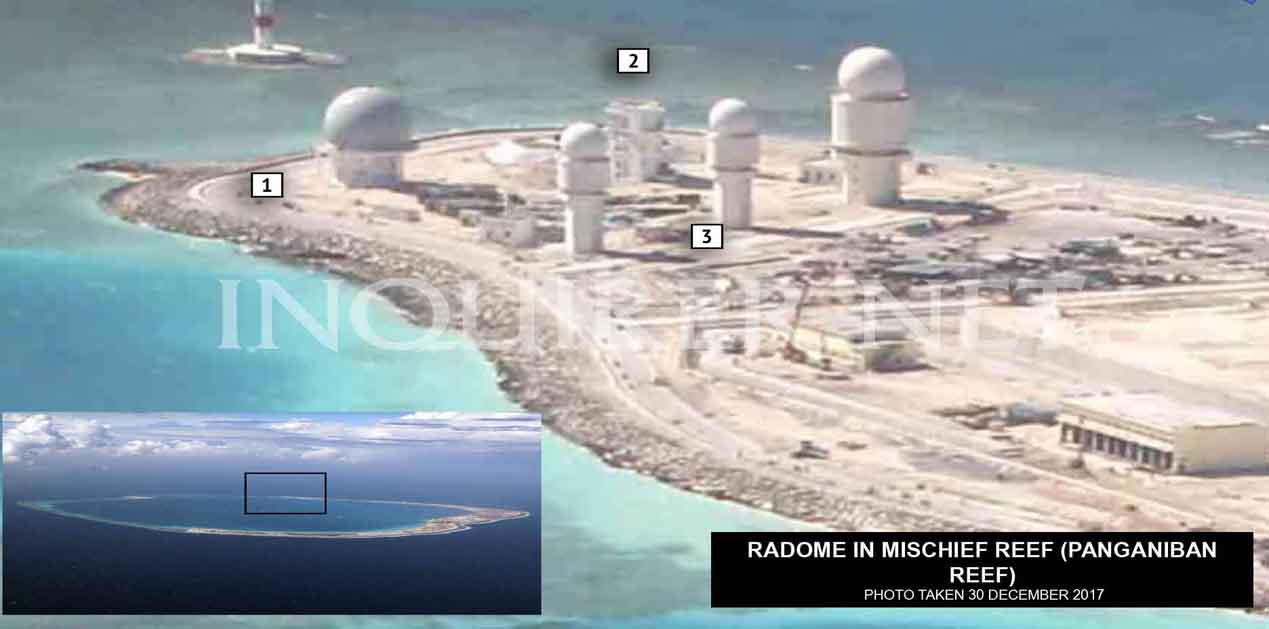In September 2015 from the lawns of the White House, Xi Jinping announced that China would not militarise the South China Sea. Five years down the line, the picture is a complete contrast. As on today, China has effectively completed militarising the Spratly and Paracel island groups.
The entire project was fairly clear. China aimed at establishing a Monroe Doctrine in the South China Sea. It began with the absurd territorial claims. China claimed whole of South China Sea on the basis of its nine-dash line. This claim was on the basis of historic rights which is completely inconsistent with the United Nations Convention on the Law of the Sea (UNCLOS).
In 2009 China submitted the so-called U-shaped line map as its official submission to the United Nations Convention on limits of continental shelf. The U-shaped line represents the area wherein China claims sovereignty over all the features and waters within. What started off as a mere claim to the islands (1946-47)progressed over the years to a claim to adjacent waters (1970s) and further the addition of the ‘historic rights’ argument happened in 1998.
After laying claim to the whole of the South China Sea, China began consolidating its claim. The aim was to achieve a fait accompli. China began reclamation in the Spratly and Paracel islands. Once hard structures were erected it was a point of no return. The reclamation has done irreversible damage to the marine ecology. Not to mention, China has spurred the reclamation race where other claimants have also dredged and constructed artificial islands, though nowhere comparable to what China has done.
After completion of the reclamations, China began to gradually militarise it. Initially, China played around with the word ‘militarisation’: implying that what it was doing was in fact defensive and hence cannot be termed as militarisation. Clever play of words! Let’s examine this further. So, what was China defending itself against? The answer: against Freedom of Navigation Operations (FONOPS) by the US Navy. The US Navy was conducting regular FONOPS in the South China Sea since 2015 against Chinese reclamations; but China used it as yet another justification for its ‘defensive’ posture. During the 50th ASEAN Foreign Ministers meeting in Manila when Vietnam wanted a stronger joint-statement (concerns over land reclamations & emphasis on non-militarisation), Wang Yi brushed it off as though China was not guilty, and that it was Vietnam that was actually militarising the South China Sea.
This week at the East Asia summit, Wang Yi, the Chinese Foreign Minister repeated the rhetoric; Wang said that China’s island-building activities are aimed at defence, improving living conditions and providing public goods in the South China Sea. How an airstrip or stationing of air defences serves public goods, is anybody’s guess. One would remember that China had made a similar absurd justification for its submarine movements in the Indian Ocean by claiming that its submarines were aimed at anti-piracy.
While such rhetoric may seem preposterous, it also shows the sheer brazenness of Chinese actions. Chinese have made their motives very clear, and that they’ve resorted to some flimsy justification deliberately shows that they mean business. It is a raw display of power. It has been China’s aim to fully control the South China Sea and through building artificial islands and militarising it, it has proved that it rules the South China Sea.
China has created artificial islands in all of South China Sea. There are seven reclamations in the Spratly islands and twenty in Paracel islands. The Asia Maritime Transparency Initiative notes that China has undertaken ‘unprecedented dredging’ in the Spratly islands and has created 3200 acres of new land.
In June 2015 Wang Yi had declared that all of China’s reclamation activities were complete. This was contrary to the facts on ground for soon after China began working on reclamation work in the Paracel, adding 25 acres to Tree Island as on today. By 2018 Satellite imagery had accurately captured the status of all of China’s artificial islands. The artificial islands had fully developed into air and naval bases.
Let us take a look at the extent of militarisation of the South China Sea. In Spratly islands – Subi Reef, Fiery Cross Reef and in Mischief Reef there are 3000-metre-long runways, hangars that can accommodate about 80 combat jets, larger hangars for transport aircrafts, bombers, and refuelling aircrafts, tall sensor and communication facility with radome, buried storage facilities for fuel and supplies, underground storage tunnels for arms, radars, control towers, and point defences with guns. On Fiery Cross Reef, there are Close-in Weapons System (CIWS) emplacements. On the other features in the Spratly islands – Hughes Reef, Gaven Reef, Johnson Reef and Cuarteron Reef, China has built helipads, lighthouses, communication facilities, radome, solar panels and wind turbines.
In the Paracel Islands, China’s main military base is built on the Woody Islands. It is also the ‘capital’ of the administrative units of Xinsha, Nansha and Zhongsha. This reclamation hosts 16 small hangers for combat aircraft. As noted earlier, each of these hangars can house 20 jets. In 2016 China deployed HQ surface-to-air missile which was eventually claimed to have been withdrawn but as per satellite imagery, the system is still seen on the northern part of the island. The same year, China also test fired anti-ship missile. A J-11 was also spotted. Experts see Woody Islands as a ‘blueprint’ of what China intends to do with its artificial islands in Spratly. Tree Island is work in progress and is set to replicate Woody Island. Palm Island is developed as a helicopter base and said to be important for PLA-N’s anti-submarine operations.
An equally worrisome development would be in the network of sensors and communication capabilities called as Blue Ocean Information Network that China has built between Hainan and Paracel Islands. These consist of ‘Ocean E-stations’ (floating integrated information platforms) that have several sensors. In this case also China has described its purpose for ‘environment monitoring and communications system’ but this is clearly a dual-use network. Ocean E-stations will collect environmental data which would be useful for PLA-N to understand active and passive sonars better in underwater. Analysts warn that these networks will provide ‘information advantage’ to China during a conflict. As if now this network is still nascent but China has set deadlines for its expansion. It is to be integrated with the Belt and Road Initiative (BRI) and by 2035 it would be a part of BRI marine network construction to support the Maritime Silk Road. By 2050 it would be a global reach. We, sitting in the Indian Ocean, should be alarmed.
China has thus successfully implemented its A2/AD (Anti-Access/Area Denial) strategy in the South China Sea. China whether one likes to hear it or not, now has control of the South China Sea. It appears to have overcome the first-island chain problems. In any future conflict breaching Chinese fortifications is going to be very costly. Further, China has intentions of making a new maritime law, now that voices are stronger in asking China to abide by UNCLOS.
China’s reclamation was done in record time, so to say. It started in 2013 and was nearly completed in 2016. During this period, the international community failed to stop Chinese expansion. The US failed at it and the ‘pivot’ was too late and of little use on ground. ASEAN also failed to come together to condemn China. The other claimants in the South China Sea could not act in concert. Until recently even India has been hedging vis-à-vis China. Overall, the global community has been too late to grasp the threat from China. National interest and over-cautious approach of the rest of us has come in our way of collective action against China’s violation of international law. Everyone seems to have taken China at face-value, enabling Chinese perfidy to continue. China has been consistent in its game of deception. Hopefully, a consensus and resolve amongst the major powers should be able to put an end to this. China needs to be pressurised to abide by the existing international law.
Endnotes
- ‘China Island Tracker’, Asia Maritime Transparency Initiative, CSIS.
- Fang, Alex and Shotaro Miyasaka, ‘China calls US 'biggest driver' of South China Sea militarization’,Nikkei Asia Review, 10 Sep. 20
- ‘Exploring China’s Unmanned Ocean Network’, Asia Maritime Transparency Initiative, CSIS.
- Tiezzi, Shannon, ‘China Won’t ‘Militarize’ the South China Sea — But It Will Build Military Facilities There’ The Diplomat, 16 October 2015
(The paper is the author’s individual scholastic articulation. The author certifies that the article/paper is original in content, unpublished and it has not been submitted for publication/web upload elsewhere, and that the facts and figures quoted are duly referenced, as needed, and are believed to be correct). (The paper does not necessarily represent the organisational stance... More >>
Image Source: https://i1.wp.com/amti.csis.org/wp-content/uploads/2018/02/MischiefD-Radome-30DEC17-Final-BOX.jpg











Very informative and well articulated.
Post new comment